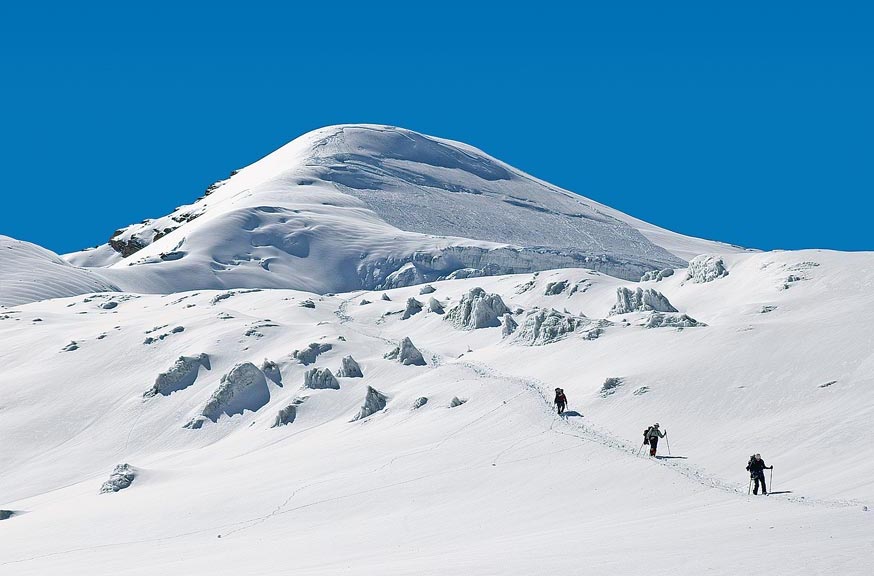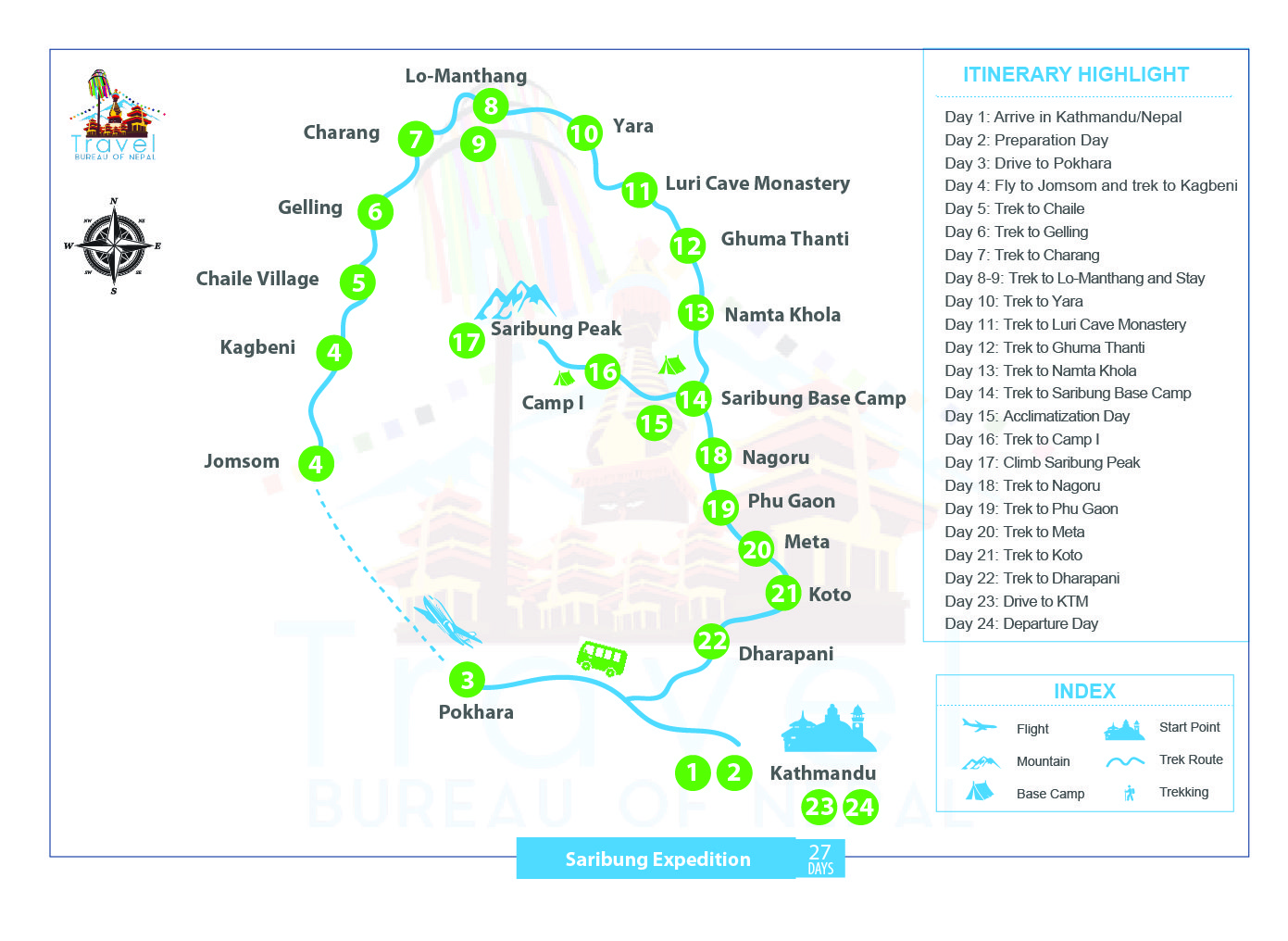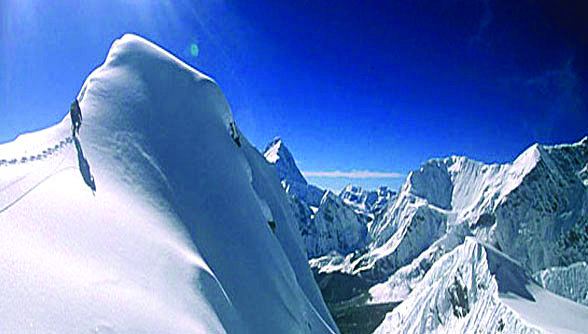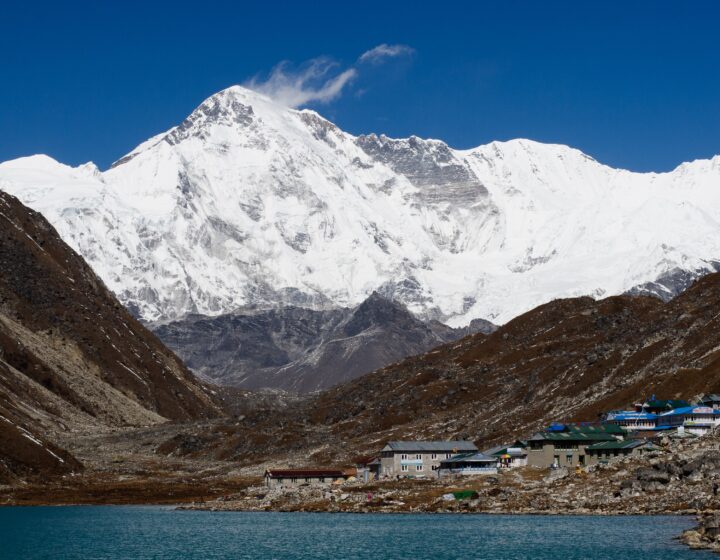- Details
Detailed itinerary
Itinerary- Tour Includes/Excludes
- Useful Info
- Trip Map
- FAQ

Trip overview
The Saribung Expedition is a well-known trekking peak in the Mustang region. Saribung peak climbing (6346m) is located in the Damodar Himal range on the Nepal-Tibet border, near the Upper Mustang trekking trails. Saribung pass trekking provides stunning Himalayan views of Mt. Dhaulagiri (8167m), Mt. Manaslu (8163m), and Mt. Annapurna (8091m), as well as 24 snow-capped mountains. The place is ideal for four different trekking attractions: the last forbidden kingdom of Nepal mustang; the beautiful landscape; mixed culture; and the challenging Saribung pass. The Nepalese government launched the Saribung expedition in 2006. The Travel Bureau of Nepal devised the Saribung expedition for nature-loving trekkers who want to explore Nepal’s restricted track – Upper Mustang trekking and Nar Phu valley trekking at the same time.
The travel bureau of Nepal led us along the scenic Annapurna circuit trekking trail until Koto. After a 5–6-hour journey from Kathmandu, the trek to Saribung Peak begins from Kagbeni. The trail ascends from Jomsom Mustang via Manthang, and the Saribung pass ends at Besishar. We make arrangements based on the trekkers’ wishes and vacation schedules. Although autumn and spring are the finest seasons for trekking in Mustang Saribung, we offer trips all year. Saribung pass trekking requires a high level of physical fitness. The Travel Bureau of Nepal has organized various groups in relevant locations with great life experiences in the Nepal Himalayas since the Saribung Pass trekking trail was opened!
Expeditions in 2023 and 2024 with proper safety backup and gear
A professional and experienced climbing guide will lead your journey to the Saribung. As a precaution, we keep an oxygen cylinder and extensive first-aid kits on hand. There will be plenty of Trek personnel to help you. As a self-sufficient squad, we transport all camping equipment and tented gear, as well as food. On this Himalayan excursion to Saribung, we also provide all the necessary climbing equipment. Booking is now open for designing this Saribung adventure for 2023 and 2024; please let us know your time frame and criteria to make your fantasy climbing trip in Nepal’s Upper Mustang region.
Highlights:
- Saribung Peak has recently been available for climbing (2006).
- Damodar Himal.
- Tibetan-like landscape, culture, and people.
- The lively market town of Jomson on the Annapurna Circuit
- The dry, desert region of Upper Mustang.
- The Saribung La pass (6,000m).
- Views of Dhaulagiri, Manaslu, and the Annapurna range.
Itinerary
Day 1: Arrival at KathmanduArrival in Kathmandu, a city full of vibrant markets, stunning temples, and majestic pagodas. A representative from our company will meet you at the airport and drive you to our hotel. Our tour leader will give you a brief introduction and important information regarding the trek. The remainder of the day will be spent familiarizing yourself with the retail locations closest to your hotel and purchasing equipment.
Today, we will complete the appropriate documentation before traveling to the Mustang region. You will also be briefed on various parts of the city when you return to your accommodation, and you may have time to do some last-minute shopping in Thamel, Kathmandu's tourist district.
6-7 hours' drive from Kathmandu to Pokhara and its stunning Phewa Tal (lake), followed by check-in at your accommodation near Phewa Tal. With so many stores, bars, and restaurants to choose from, Lakeside offers enough to see and do.
Today we fly from Pokhara to Jomson, a 20–25 minute flight with views of the famous Kali Gandaki Gorge (the world's deepest) and vistas of numerous massive peaks, including Mt. Dhaulagiri, the Annapurna Ranges, and Machapuchare (Fishtail). Our three-to-four-hour journey to Kagbeni begins after landing in Jomson. Kagbeni also serves as a checkpoint where authorities will scrutinize your documents before allowing you to access the restricted Upper Mustang region. We will spend the night there.
We'll start early today to avoid the heavy winds that will arrive later in the day. We ascend after leaving Kagbeni, offering us beautiful views of the village and Mt. Nilgiri (7061m). We can see Nilgiri in the early morning light, which is a warm orange due to the sun's reflection. We follow the Kali Gandaki River's east bank until we reach the broad Chhusang Valley. The trail proceeds east, across more arid terrain typical of the Mustang region. We soon arrive in Tangbe, the first significant settlement, with its red and whitewashed dwellings on opposite river banks and spectacular views of the Kali Gandaki River.The trail then leads to Chele, where we can see the Himalayan ranges. Tonight we are staying at Chele.
Today we will climb the steep slopes till we reach a stone cairn at 3540m, from where we will descend to the small village of Samar, which has chortens (stupa religious monuments) and other Buddhist constructions. After leaving Samar, we drop into a big canyon before ascending to a 3800m ridge and descending to the secluded Shyangmochen Village for the night.
From Geling, the trail ascends to Nyi La Pass (3932m), then descends to follow the Tangmar Chu River and its Mani stone walls. The trek next leads us to Charang Village, with its massive five-story Dzong (monastery) and red Gompa and Thankas (forms of art).
Today's trail is primarily uphill as we make our way to Lo-Gekar, home to one of the world's oldest Tibetan monasteries. Then we ride our horses to Lo-Manthang after visiting Lo Gekar. Before reaching Lo-Manthang, the trail travels through the historic walled city of Lo-Manthang before descending and crossing a stream.
Today we acclimate before ascending to higher altitudes. On this day, health professionals advise being active. So we can climb to Namgyal Gompa, which is located at the summit of a peak, and then proceed to Tingkhar, which is located northwest of Lo Manthang. We visit a little community of roughly 40 dwellings before returning to Lo Manthang for the night.
Today, we'll hike for six to seven hours until we reach Yara, where we'll spend the night.
The Luri Cave Monastery is claimed to be the Mustang region's oldest (15th century) cave monastery. Today's trip will last roughly three to four hours till we get to Luri Cave Monastery, where we will spend the night.
We travel for roughly five to six hours today, crossing a 5100m pass before arriving at Ghuma Thanti, where we pitch our tents for the night.
Our trip today will last around six to seven hours, beginning with the 5600m pass and continuing until we reach Damodar Kunda (lake), where we will camp for the night.
Today we will travel for six to seven hours before climbing to base camp, where we will pitch our tents for the night.
Today is the day to acclimate and tour the nearby region to aid the process. We'll pitch our tents here tonight.
We leave early in the morning for a five-to-six-hour journey. Climbing at high altitudes and through snow is physically demanding. We shall spend the night here.
We get up quite early since we have an eight-or nine-hour day ahead. This is the day when the adrenaline starts pumping as we make our way through the snow to the summit. You'll be out of breath at the top, first because of the effort it took to get there, and second because of the breathtaking panoramic views. This is a picture-perfect moment. We'll then spend the night in Base Camp.
Today we will pass the Saribung Pass and descend the trail to Nagoru, where we will spend the night.
Today we will travel across the Saribung Pass and down the trail to Nagoru, where we will spend the night.
Today we hike for five to six hours through the dusty Tibetan plateau and along the valley to Phu Gaon Village. This area is remote and frequently thought to be lost to the rest of the world, and it is home to the Gurung, Lama, and Ghale. Tashi Lhakhang, a historic Buddhist monastery, is claimed to be one of the world's finest Buddhist monasteries built by the legendary Karmapa Rinpoche. Phu Gaon offers spectacular views of the Himlung Himal and other snow-capped summits. We'll spend the night here.
Today we will hike for five to six hours along the Tibetan plateau before descending to Meta Village. We pass the ruins of earlier Khampa towns, where Tibetan refugees lived after fleeing Tibet. From Meta, we have a beautiful view of Annapurna II and Lamjung Himal. We'll spend the night here.
The first hamlet we visit on our five-to-six-hour hike today is Tamang, where we can see Mt. Manaslu and other snow-capped peaks before traveling down to Danque Village for lunch before continuing to Dharapani, where we will spend the night.
The first hamlet we visit on our five to six-hour hike today is Tamang, where we can see Mt. Manaslu and other snow-capped peaks before traveling down to Danque Village for lunch before continuing to Dharapani, where we will spend the night.
Today is our last day as we return to Kathmandu, where you will be met and transported to your accommodation.
Your journey in Nepal includes an associate on the trip that ends today! Our agent will transport you to the airport three hours before your scheduled flight.
Included
- Private arrival and departure transfers for domestic and international flights are available.
- Per the schedule, standard hotels in Kathmandu and Pokhara are on a twin share bed and breakfast basis.
- While walking to Saribung Peak, full board meals are provided.
- While on the excursion, drink water, tea, and coffee properly.
- While climbing, stay in a tent camp.
- As specified in the schedule, a welcome meal will be served.
- A half-day guided city tour with world heritage entrance fees is on the itinerary.
- The schedule includes domestic flights and airport fees.
- As needed, private transportation to and from the trek's starting and conclusion places is provided.
- Royalty on Saribung Expedition Climbing Permit and other government taxes
- Personal and group climbing equipment: Crampons, climbing rope, ice axe, Jumar, harness, the figure of eight, and a Carabiner
- All camping gear, including the member tent
- Professional local Guide with Wilderness First Aid training.
- Supplemental oxygen tank or Portable Altitude Chamber (PAC) / Gamow Bag (A life-saving equipment in the event of Acute Mountain Sickness) in addition to a full First Aid Kit
- Trekking map for the respective region.
- Climbing guide with all of his allowances and expenses.
- Trek cook, food staff, Trek Sherpa, and other support personnel
- Porters will transport all personal and group items.
- All workers, including porters, must have adequate insurance and hiking equipment.
- Fees for TIMS and trekking permits, as well as National Park and Conservation admission fees.
Not Included
- Fees to enter Nepal, Travel insurance of any kind, overseas airfare, and airport tax
- All drinks and main meals are included in cities.
- Personal expenses include a hot shower, a battery charge, a phone, and beverages
Useful Info
- Bring essential hiking gear.
- Keep light snacks on hand to keep your energy and blood sugar levels balanced, such as muesli, chocolates, chips, and nuts.
- Stay hydrated and your metabolism will speed up.
- Have the physical fitness required to perform minor ascents and descents
- Don't rush and keep your cool when hiking.
- Follow the directions of the guides to discover more about the site.
- To have a successful trek, follow all laws and regulations.
- Avoid alcohol as much as possible, yet a few pegs are permitted for certain alcohol regular trekkers to keep your senses intact.
- Maintain good health because concerns such as asthma, vertigo, avalanches, and altitude sickness can arise.
- Take note of the finest seasons for amazing encounters.
Trip Map

FAQs
-
How Difficult Is Climbing Saribung Peak?
The following factors determine the difficulty of climbing Saribung Peak: Weather Condition and Temperature The climbing path you've picked Physical Fitness Basic Mountaineering Training and Climbing Skills High Altitude Sickness occurs on occasion. The total distance traveled during your trip. Clothing and accessories
-
Which seasons are ideal for climbing Saribung Peak?
Saribung Peak climbing is best done in the spring and autumn. The ideal months for climbing Saribung Peak are March to June and September to November.
-
What Should I Bring for Saribung Peak Climbing?
What You Should Bring: Valid passport, two additional passport-sized photos, and airline tickets Insurance documentation, Photocopies of the passport and visa form (easily obtained at Kathmandu airport) Dollars in cash for obtaining a Nepalese visa at Kathmandu International Airport Personal Climbing Equipment: Axe de glace Crampons Harness Slings made of tape (2) Karabiners with screwgates (2 locks, 2 unlock) Descender/eight-figure Mountaineering boots made of plastic Ascender/Jhumar Helmet Group Climbing Equipment: Rope* Snow bar* Ice hammer* Ice screw* Hea A bandana or headscarf can also be handy in dusty situations. a cap that is warm and protects your ears (wool or synthetic) Extra batteries and bulbs for your headlamp UV-protective sunglasses Prescription sunglasses (if required) The upper body Shirts made of polypropylene (1 half sleeve and 2 long sleeves) Thermal shirts for light and expedition use Windstopper fleece jacket or pullover Waterproof (preferably breathable fabric) shell coat * Down vest and/or jacket * Waterproof and breathable Gore-Tex jacket with hood Hands 1 lightweight pair of poly-liner gloves 1 pair of thin wool or fleece gloves 1 pair of mittens, each with a Gore-Tex overmitt matching, waterproof, polar-fleece mitt liner. The Lower Body Briefs made of non-cotton material 1 hiking shorts pair 1 pair of hiking pants 1 pair of thermal lightweight bottoms 1 pair fleece or woolen pants 1 pair of breathable waterproof shell pants Feet 2 pairs of heavy-duty polypropylene or wool socks 1 hiking boot pair (sturdy soles, water-resistant, ankle support, "broken-in" ) with extra laces 1 pair of sneakers, running shoes, or sandals Socks made of cotton Gaiters \Sleeping 1 -30-degree-centigrade sleeping bag Fleece sleeping bag liner Travel Bags and Rucksacks * 35 to 50 liter daypack/backpack * 1 medium rucksack or 1 large duffel bagfor carrying valuables, with good shoulder cushioning Padlocks for duffel bags, small 2 huge rucksack coverings that are waterproof (optional) Medical Personal first-aid kit, small (simple and light) Aspirin, bandages, and plasters (Band-Aids) 1 package for skin-blister repair Anti-diarrhea medication Headache relievers Cold and/or cough medicine Anti-altitude sickness pills: Diamox or Acetazolamide Ciprofloxacin and other stomach antibiotics: Do not bring sleeping pills as they are a respiratory depressant! 1 pair of earplugs Extra prescription glasses and contact lens supply Useful items 1 roll of small mending tape, 1 sewing repair kit 1 cigarette lighter, 1 tiny matchbox 1 compass or GPS device (optional) 1 watch/alarm clock 1 digital camera with additional memory cards and batteries Ziploc bags, large 2 bottles of water (1 liter each) 1 miniature folding knife Binoculars (optional) 4 large waterproof disposable trash bags Toiletries 1 quick-drying medium towel Toothbrush/paste (preferably biodegradable) Soap with multiple uses (preferably biodegradable) Deodorants Clippers for nails Moisturizer for the face and body Female hygiene items Mirror, Little Personal Care Wet rags (baby wipes) Toilet tissue/toilet paper Extras/Luxuries: antibacterial handwash Book reading Trail guidebook/map iPod, journal, and pen Travel games such as chess, backgammon, scrabble, and playing cards (to pass the time in teahouses and/or camps) 1 modest bathing suit Binoculars (optional) The converter of voltage (from 220 to 110 ampere) Adapter for plugs (2 round pegs to 2 flat pegs) Use a lightweight pillow case (if your tea places give cushions) or your belongings as a pillow.








